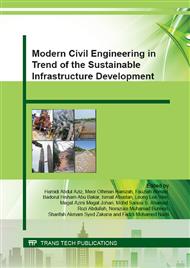p.581
p.587
p.593
p.599
p.605
p.611
p.617
p.623
p.629
Studying Effect of Riverbank Filtration (RBF) on Ground Water Using ‘Time-Lapse Electrical Resistivity Imaging’ at Kuala Kangsar, Perak
Abstract:
Riverbank filtration (RBF) is a natural water pre – treatment, safer and cost – effective that uses geology instead of chemicals to pre – treat river water. The process occur during the infiltration process of river water passing through riverbank material towards a production well during a pumping test, where the removal of biological and colloids take place. Abstraction of ground water are required for RBF to occur, hence pumping test were done. As pumping test took place, ground water was in continuous discharging and recharging process throughout time. Objective of this research is to study the dynamic changes of ground water during discharging and recharging process for 72 hours by using time – lapse electrical resistivity imaging (TLERI). Resistivity, which uses current to measure the resistivity of subsurface was used during the pumping test to monitor ground water changes and infiltration of river water during RBF process. Results show significant changes on TLERI data from the first session until the last session. Dynamic changes occurred around the riverbank and production well section while others show less significant changes.
Info:
Periodical:
Pages:
605-610
Citation:
Online since:
October 2015
Authors:
Price:
Сopyright:
© 2015 Trans Tech Publications Ltd. All Rights Reserved
Share:
Citation:


